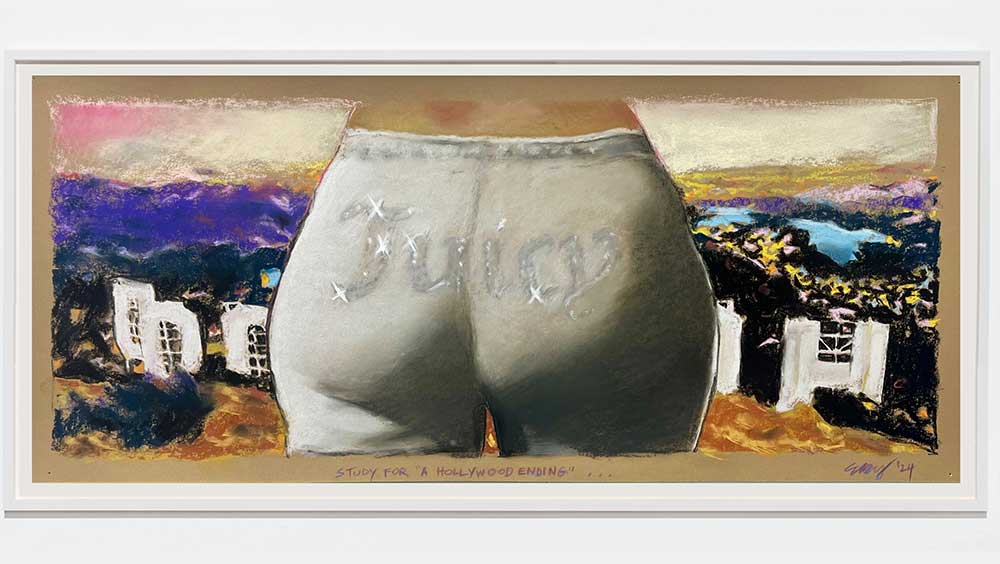
Eric Yahnker. Study for a Hollywood Ending, 2024. Pastel on Stonehenge, 11 x 24 in (28 x 61 cm). Image courtesy The Hole, Los Angeles.
by JILL SPALDING
Say “Los Angeles” and the world thinks Hollywood. Understandable, given the movie industry’s reach and influence. But far more emblematic of the changing culture, the rethinking of community, and the volatile issue of identity is art. The challenge for the critic is to continually revisit what constitutes art, and to winnow out work, be it accomplished or tentative, that stimulates, marks, innovates, or rethinks. Work made with talent and passion. Work, above all, that is alive for us now.
Beginning to look tired, though name galleries rely on them, are famous dead artists – one more Warhol (at The Broad), yet another Basquiat (at Gagosian). More appealing, the showings – recent and current – of sidelined masters: at LA Louver, a gorgeous group of Diebenkorn drawings; at Nonaka-Hill, the once-celebrated Japanese artist Saori (Madokoro) Akutagawa’s arresting abstractions painted on jesso, conceived to “break the rules” with thrusting imagery derived from native folklore. Boldest, Michael Werner will open its long-anticipated West Coast gallery with a showing of 10 paintings by the 19th-century French painter Pierre Puvis de Chavannes, as well as featuring the artist Markus Lüpertz, whose work was openly influenced by Chavannes. So admired by Cézanne, so dear to Hitler, and long domiciled at the Metropolitan Museum of Art, Chavannes’ idyllic portrayals were then relegated by art critics to the dustbin of history, until the discovery of a sketchbook filled with long-nailed dwarves plucking guitars drawn as nude female bellies informed the gestalt theorist Rudolf Arnheim’s postulate on schizophrenia in art. This exhibition, however, is the first to bring Chavannes back into the light.
Wearing thin, old tropes now rendered digitally as “art”, such as the chaotic assemblage of straw, broken crayons, cigarette butts and a torn plastic bag on recent view at the Felix art fair. Also, those ubiquitous cartoon images that play into the persisting popularity of manga but which, lacking the subtext of, say, the bomb in Japanese anime, are rendered toothless by their spurious cuteness.
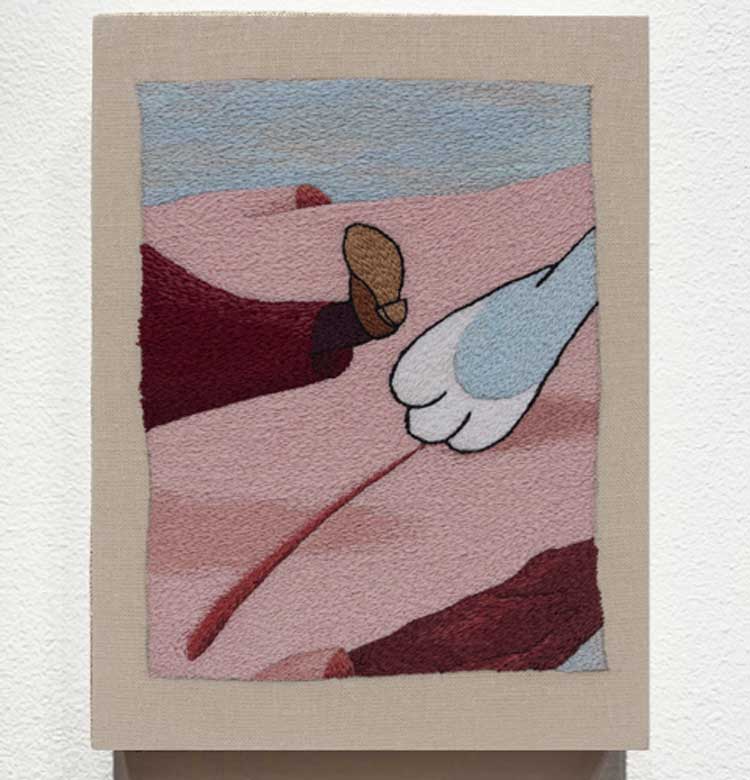
Peter Frederiksen. Not Yet Sure Of The Lengths To Which I Would Go, 2021. Freehand machine embroidery on linen, 8 x 6 in (20.3 x 15.2 cm). Installation view, Steve Turner Gallery, Los Angeles. Photo: Jill Spalding.
Contrast these with the wondrously dexterous small “freehand machine” embroideries by Chicago-based Peter Frederiksen that Steve Turner just showed, which would be too clever by half did they not undercut cute with the threat of imminent peril – the Bugs Bunny everyman chased off a pier or clinging for dear life to the edge of a cliff or struggling to cast off an enemy. As compelling, at Anat Ebgi, two mixed-media artists forge a new language: Charlotte Edey rethinks drawing with pearl-strewn embroideries that relate thread, line and surface; Palestinian-American artist Jordan Nassar encodes conflicting notions of identity and homeland into mural-length geometric needlepoints patterned with Islamic symbols, and an intricately pieced glass-tile work evocative of a Byzantine floor mosaic.
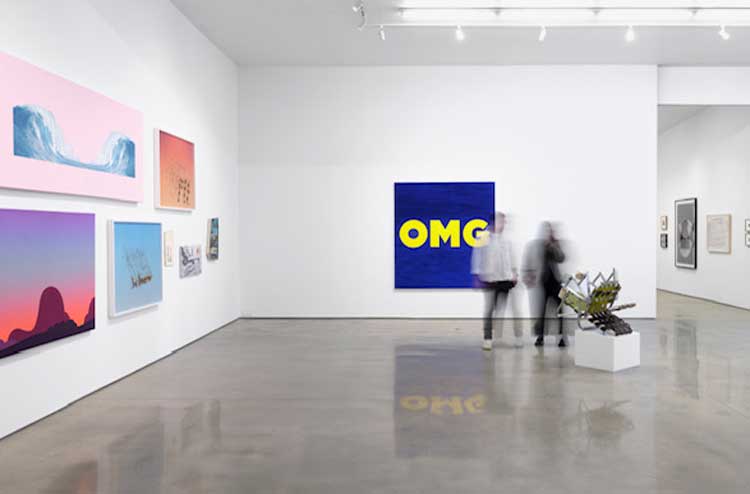
Installation view, HOLLYWOOD DREAM BUBBLE: Ed Ruscha's Influence in Los Angeles and Beyond!
Without the edge, but instructive and wonderfully witty, Hollywood Dream Bubble at The Hole is a motley collection of 72 artists – most LA-based – including Mike Kelley, Lari Pittman, Catherine Opie, Pippa Garner and Jason Rhoades, whose exuberant works riff on Ed Ruscha’s visual language of congealed words, saturated sunsets, serial imagery, the wind-ripped American flag, and signature lettering that works OOF into OMG, to show how Ruscha, fresh off his bi-coastal museum retrospectives, has deeply coloured the zeitgeist.
A mini-trend of sorts with, hopefully, the lifespan of a moth, is the plethora of colourfields sectioned into rainbows that read as compass art: digitally produced, they hold none of the power of a Sean Scully or Frank Stella. More convincing essays in colour are John McAllister’s surreal landscapes at James Fuentes that layer stippled pinks, violets, lemon yellow and cobalt blue to create uncanny perspectives. At Philip Martin, Pamela Jorden creates vivid landscapes by painting the canvas that remains exposed after pushing and pulling the linen to create an uneven terrain. And (just ended) at Tanya Bonakdar, a radiant museum-level mini-retrospective of Tomás Saraceno’s iridescent Plexiglas stabiles that extended to paintings for dogs, a spider/cosmic web, outdoor sculptures that function as animal habitats, a row of geodes containing all the minerals used in a cellphone, and below it a sign that invited you to leave your phone with them while you were touring the show.
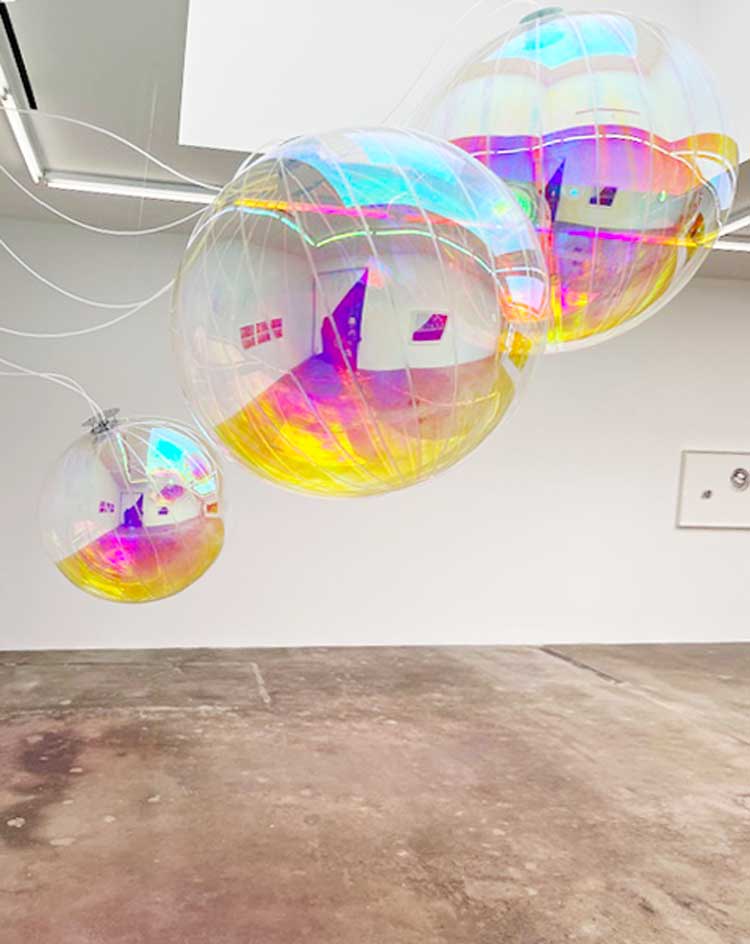
Tomás Saraceno: Live(s) on Air. Installation view, Tanya Bonakdar Gallery, Los Angeles. Photo: Jill Spalding.
Surging beyond trend is craft honed as art. Make that high art since, centuries after Byzantine mosaics, Persian carpets, Japanese celadon, Chinese jade carvings, Gothic stained-glass windows, Cellini’s gold salt cellar and Della Robbia’s glazed terracottas were more prized than Rembrandts, the modern world restored hand-wrought materials to museum status – first with such as Anni Albers’ intricate weavings, then, a generation later, with Betye Saar’s racial-challenging combines, Faith Ringgold’s painted storyboard quilts and Sheila Hicks’s dyed-wool totems.
Latterday efforts have raised craft to its own pantheon, marked by mixed-media mastery, team engineering and stunning assemblage – EV Day’s floated accessories, Sarah Sze’s stepped, swirled, blown and cascaded compositions of plastic bottles, broken glass, boxes, tools, torn photographs and leaves, and El Anatsui’s prodigious bottle-top wall hangings. As arresting is the astonishing prowess with hand-crafted materials: rivalling Black portraiture in galleries here now are prodigious works involving beading, sewing, knitting and weaving organic materials that deliver the gravitas of a painting. Recent standouts are Vamba Bility’s framed wall installations at the Hammer Museum, textured with nutshells, brick, yarn, metal chains and burnt wood. And at Karma, previewing his Venice Biennale presentation in the Uganda Pavilion, Sanaa Gateja’s intricate “social sculptures” sewn to bark cloth, built from thousands of tightly rolled recycled paper beads, each in itself a “complete sculpture”. Blurring the lines, too, is the sit-on-them conflation of sculpture and furniture. At David Zwirner, one of Franz West’s dangling thread sofas; anchoring the Albertz Benda space at the inaugural Los Angeles Miami Design Fair (see below), Darren Romanelli’s armchairs pieced from indigenous fabrics to create new narratives, and surfacing everywhere, woods, resins and clay worked into sculptures that double as lighting fixtures.
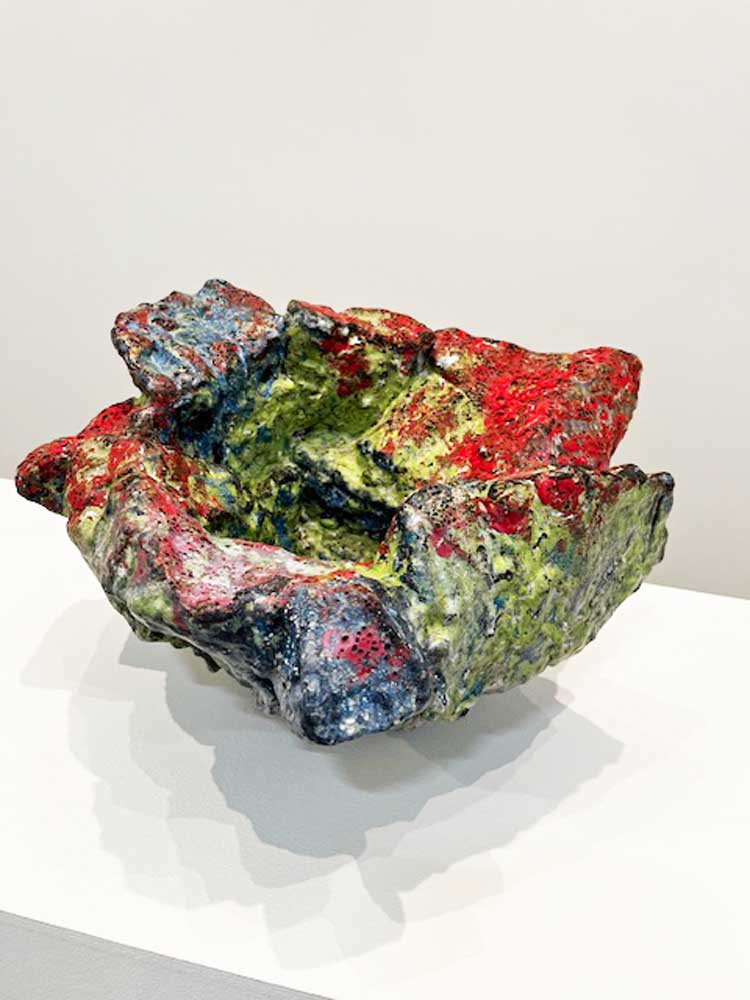
Jay Kvapil. Installation view, Recent Landscapes, Diane Rosenstein Gallery, Los Angeles. Photo: Jill Spalding.
Ceramics muscled in early with monumental clay firings by such as Viola Frey, Betty Woodman and Sterling Ruby, then took a generational break and now are back in full force. Standouts showing now aim for dissonance, technical wizardry and challenging aesthetics. Says Jay Kvapil of the faceted sculptures – shown at Diane Rosenstein – formed from plaster moulds of rocks and “stitched” materials “taken from the earth”: “I use raw ceramic glaze materials in abnormal ways and force the materials to melt, fuse, bubble, crawl and drip in the firing – with the result being somewhere between chaos and control.” At the Los Angeles County Museum of Art, Simone Leigh’s sculpted avatars of Black womanhood wrested from clay rise like totems to convey newborn power and possibility.
Painting hasn’t been sidelined but, with the exception of Black portraiture, has detoured from figuration to landscapes seen not as in nature but in the mind’s eye. At the Michael Kohn gallery, the Indian artist Siji Krishnan conjures a luminous atmosphere from watercolour on rice paper that interrelates, on one radiant plane, birth, friendship and treescape. Two breakthrough painting shows this season that still resonate; at Pace, Li Songsong’s landscapes built from paint applied as thickly as a mason might layer bricks, and at Hauser & Wirth the stunningly fresh take on Pat Steir’s signature drip technique that the artist, age 84 and diagnosed eight years ago with colour blindness specific to the colour blue, developed from a colour-drenched palette of blues referencing ocean and sky.
Commercial yet gripping are crowd-pleasing exhibitions that, like art fairs, have been organised to deliver an “experience”, not of a place or a happening but of a visceral emotion. At the Petersen Museum, no-component-too-small-to-be-modified translates to high art in a knock ’em dead display of lowriders that have been painted, upholstered, engraved, bezelled, stippled and glittered into world wonders. At Ace Mission Studios, set in a 28,000-square-foot warehouse, indigenous artist Glenn Kaino’s immersive A Forest for the Trees engages uncanny visual effects and original music to wander you through a wooded installation conceived to convey the Native American’s deep communion with nature.
Still more involving are home-grown dioramas of art wrested from actual nature. For one month at Sargent’s Daughters, Ojai-based Minga Opazo’s living sculptures wrought of fungi fed on scraps of nutrient-laced clothing to convert textile waste into regenerative soil. And what is it with dirt – too ubiquitous to mark as metaphor, or even as arte povera, and too elemental to serve as conceptual? But mark it does. Commune with the Dia Foundation’s 1980 Manhattan installation of Walter de Maria’s Earth Room and you’ll never forget it. The same goes for Michael Heizer’s raw canvases of moved earth. Carried through to the present, Miami-born Teresita Fernández is enjoying a NY moment at Lehmann Maupin with the charcoal, volcanic and rusted iron sand layered panels that make up her Soil Horizon show. Here, at the Charlie James Gallery, Jackie Amézquita addresses life, death, migration and the cross-pollination and dissolution of people, plants and insects across Central and South America with framed wall-length soil paintings composed of crushed fossils, earth and lava rock, variously tinted with bee pollen, cochineal or achiote, and a trio of copper panels retaining traces of rotting bananas. At her small scrappy gallery Make Room in West Hollywood, owner-director Emilia Yin (recently cited in Forbes as one of the 30 new forces in the contemporary art world) has rethought the short-term exhibition with an unforgettable installation by one-time bad-boy Chinese artist Terence Koh (known largely for the blinding light that informed his single-work show at the Guggenheim Museum). Titled Kohfee, it consists of a seductively reimagined cafe involving a coffee-scented mound of dung-infused earth rich enough to host tiny insects, walls seeded with native flora and shiny talismans, and a diminutive window that views on to an artfully landscaped section of sidewalk.
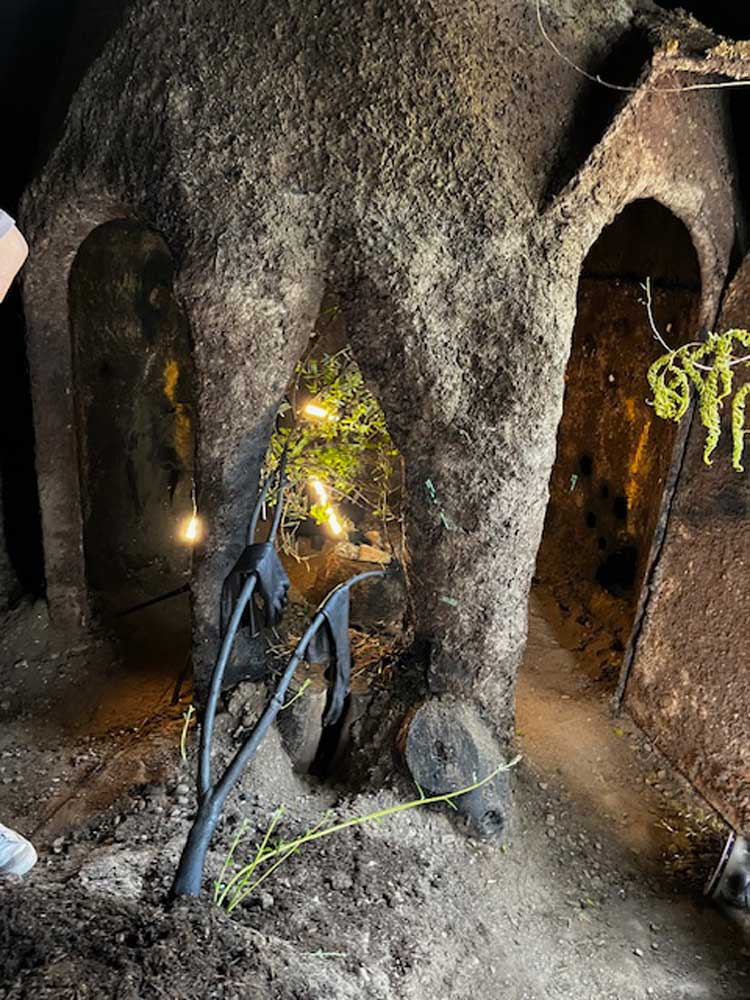
Terence Koh. Kohfee. Installation view, Make Room, Los Angeles. Photo: Jill Spalding.
Most extreme and extraordinary, following on her extreme and extraordinary recreation of the western landscape through photographs taken with a camera rigged from a silo and developed with chemicals pulled from the earth, is the visionary artist Lauren Bon’s herculean effort to reanimate and exalt the Los Angeles River. On its banks, at her bricks and mortar Metabolic Studio, to realise an environmental art project titled Bending the River Back Into the City, 18 5,000-gallon tanks trap and recycle rainwater, slabs formed from decades of dumped construction detritus have been built into ziggurats, and a vast well dug deep enough to access pristine water feeds aquaria stocked with native algae and fish. Should Bon win her battle with the city, she will have restored the river to a living entity and a source of clean water that can sustain this vast population through human encroachment and forthcoming drought. On view at her forthcoming solo show at Honor Fraser, due to open on 13 September, will be documentation of Bon’s project and a model for reconnecting the waterway to its natural floodplain.
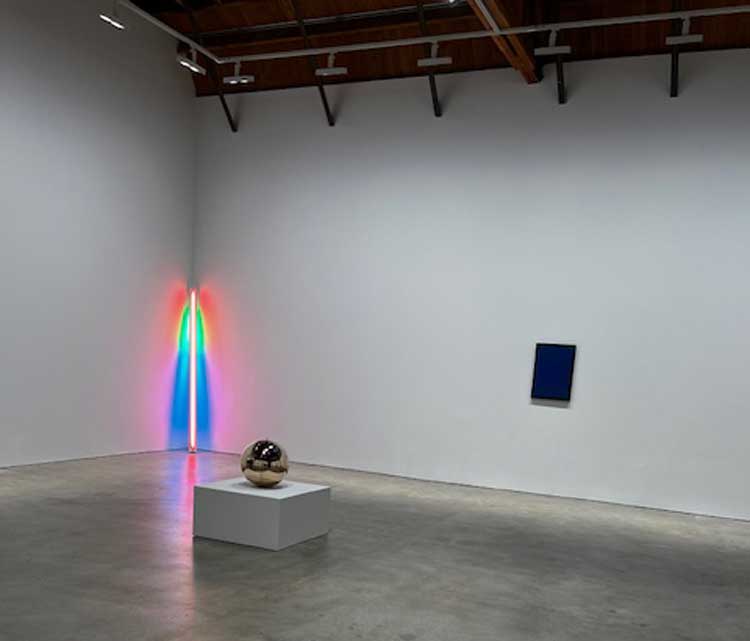
Dan Flavin, installation view, David Zwirner: 30 Years, Los Angeles. Photo: Jill Spalding.
As for happenings, there were long lines for all five days of the inaugural Los Angeles edition of the storied Miami Design Fair to view furnishings forged, hewn, poured, pieced and fired, as if by the gods, from massive blocks of basalt, vast slabs of walnut, rainbowed resins, cast alloys, glass sprouted from brass, and acrobatic ceramics. Most anticipated was the 22 May opening of the new David Zwirner gallery, a combine of buildings anchored by a vaulting white temple to name-art designed by star architect Annabelle Selldorf and launched with Zwirner’s Big Bang stable of 80 renowned artists – among them Paul Klee, Ad Reinhardt, Yayoi Kusama, Marlene Dumas, Dan Flavin, Alice Neel, Bridget Riley, Gerhard Richter, Isa Genzken, Sigmar Polke, Felix Gonzales-Torres, Joan Mitchell, Chris Ofili, Sherrie Levine, Barbara Kruger, Kerry James Marshall, Richard Serra and Douglas Wheeler: drawing admiration from attending architect Frederick Fisher, one vast wall after another given over to a single work as small as a Diane Arbus photograph; “Shorthand for expensive,” one collector noted.